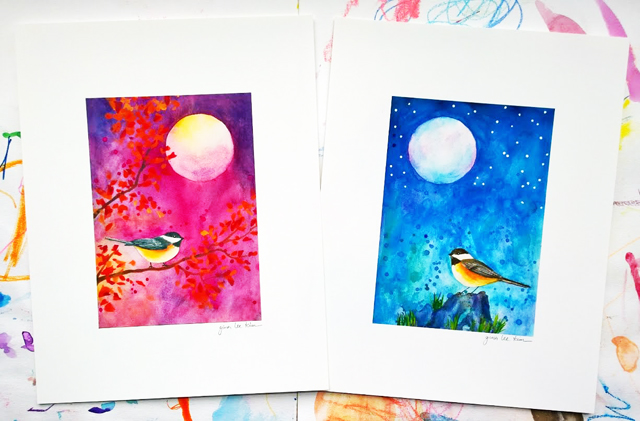Tell us a little bit about yourself.
Hello! My name is Gina Lee Kim and I’m a watercolorist that fell in love with mixed-media and art journaling. I live north of Chicago with my scientist/photographer husband, Jim, and our solar system-obsessed 3 year old son, Stephen. I’m also a registered nurse but for some miraculous, celestial alignment, I'm living a dream-come-true, artist life. Honestly, I’m just happy that my son will inherit all of his mommy’s art supplies! |
I love seeing how other artists set up their creative space. Can you tell us a little bit your studio?
Since we’re currently renting our house in IL, I converted one of the spare bedrooms that has carpeting (yikes) into an art studio. Actually it’s a shared space with my son and we love it. I pushed my black craft/painting table into the closet and hung lights. Stephen’s art table is a converted wooden bench with the seat cushion removed. It’s the perfect platform for his height. Art supplies are always available for both big kid and little kid. :)
I remember reading a study that was done in the 70’s that tried to define creativity, spirituality and that human feeling of oneness. Of course, observing the beautify of nature was one of them, but what was fascinating (and totally true!) was to watch little children make art. Not only do I love to draw and paint with my son, his doodles always serve as the backdrop to my artwork when I’m photographing them! :)
How do you organize your creative schedule?
As a watercolor artist and a mom, people often ask how I find the time to make art. There’s never enough time really, but somehow—even if all I have is 15 minutes a day—I make it work. There are certain routines that help me stay organized with my creative schedule. For instance, no matter how tired I am, I make sure to rinse my watercolor brushes, clean my palette, and replace any dirty water after I’m done painting. The rest of the studio (and house) could be a mess, but I know I’ll always have my watercolor station fresh and ready to go, beckoning me to come back to create again.
What is a typical day like for you?
Motherhood has definitely changed how I approach art. A lot of my projects are in a holding pattern during the day but after my family goes to bed and the whole house is quiet, I am working in the studio. And if inspiration hits me really hard, I’ll be up until 1 or 2 a.m. I can’t do this every night but my husband is so awesome. He does the bedtime rituals for our son and makes Stephen breakfast in the mornings so I can sleep- in. Shhhhh, don't tell anyone but coffee makes me a better artist!
What are you working on right now?
I am always working on my art journals! It’s how I brainstorm, visualize and make goals. It’s where I dream. My pages even help me pitch ideas to my editors and publishers. Art journaling is not only a place for color, texture, and words to come alive, I come alive.
I am also I’m thrilled to announce my 2015 ART LESSONS with Cloth Paper Scissors and F+W Media! I was asked by the editors to do these exclusive four volume series in which I explain a lot of my watercolor techniques and how I use mixed-media (with ink, colored pencils, crayons, oil pastels, glass bead gel, paint pen markers, transparencies, collage, a bit of sewing…you name it). These downloadable lessons come with step-by-step instructions and video links to help bring it all together. Please enjoy this short clip:
|
PROMO: ART LESSONS with Gina Lee Kim (CPS) from Gina Kim on Vimeo.
To see more of Gina-check out her website: http://www.ginaleekim.blogspot.com or follow her on Instagram username is: ginaleekim.

And lovely Gina is giving away 5 art prints of her popular chickadee prints!
To enter to win-
Leave us a comment, tell us your favorite supply to use in the studio.
The 5 lucky winners will be announced over on Gina's blog http://ginaleekim.blogspot.com on Thursday, February 5, 2015 by 12pm EST
"In the Studio" is a new feature here on the blog where I share a glimpse into friends and fellow artists and crafters spaces.
If you are interested in submitting your studio to be featured, send me an email at alisaburkesubmissions@gmail.com























































